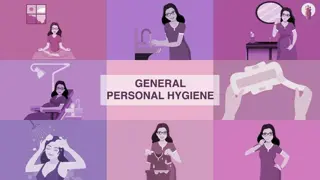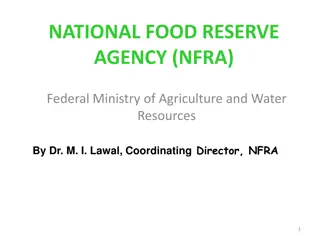Mastering Good Food Hygiene and Storage Practices
Understanding food spoilage causes, common food-poisoning bacteria, conditions for bacterial growth, ways to prevent food contamination, safe food handling practices, HACCP concept, types of perishable foods, importance of proper food storage, packaging materials for food, and recognizing signs of food spoilage. Learn how enzymes, moulds, yeast, and bacteria contribute to food spoilage and food poisoning risks.
Download Presentation

Please find below an Image/Link to download the presentation.
The content on the website is provided AS IS for your information and personal use only. It may not be sold, licensed, or shared on other websites without obtaining consent from the author. Download presentation by click this link. If you encounter any issues during the download, it is possible that the publisher has removed the file from their server.
E N D
Presentation Transcript
6 Good Food Hygiene and Storage Learning Outcomes Chapter 6 Good Food Hygiene and Storage
6 Good Food Hygiene and Storage Key Words Food spoilage Enzymes Moulds Yeast Bacteria Food-poisoning bacteria Conditions for growth of micro-organisms Cross-contamination HACCP Perishable foods Semi-perishable foods Non-perishable foods Frozen foods Star markings (fridge and freezer) 2 Essentials for Living, 3rd Edition
6 Good Food Hygiene and Storage Learning Outcomes After completing this chapter and the homework, assignments and activities that accompany it, you should: Know what food spoilage is and what causes it (enzymes, moulds, yeasts and bacteria). Know the names of common food-poisoning bacteria and how they generally enter the human food chain. Know the five conditions that bacteria need to grow successfully. Understand the four ways that food usually becomes infected. Know how to keep food safe: rules for food handlers, safe practices with food preparation, cooking and storage, and how to keep food preparation areas hygienic. Understand the concept of HACCP and be able to give an example of HACCP and how it works. Understand the following food types and what they mean for food storage: perishable, semi- perishable, non-perishable, frozen. Know what the star markings on a refrigerator or freezer mean in terms of length of storage. Be able to name a variety of packaging materials for food cooking and storage and know what each is suitable for. 3 Essentials for Living, 3rd Edition
6 Good Food Hygiene and Storage Food spoilage Food spoilage is when food goes rotten or bad. It is caused by: Enzymes Micro-organisms (moulds, yeast and bacteria) 4 Essentials for Living, 3rd Edition
6 Good Food Hygiene and Storage Food spoilage (continued) Enzymes are naturally present in fruit and vegetables. They cause them to ripen and eventually rot. Moulds cause a fluffy beard to grow on bread, fruit and vegetables. Many moulds are useful, e.g. penicillin and in cheese making. While yeast will attack some foods, such as jam, yeast has a positive use in bread making, brewing and wine making. Bacteria are everywhere. If they multiply too much, they cause food to go off. They can also cause food poisoning. 5 Essentials for Living, 3rd Edition
6 (Higher Level only) Good Food Hygiene and Storage Food poisoning Food poisoning occurs when bacteria multiply to unacceptable levels on food and then the food is eaten. Our bodies respond to this invasion with symptoms such as cramps, nausea, vomiting and diarrhoea. 6 Essentials for Living, 3rd Edition
6 (Higher Level only) Good Food Hygiene and Storage Some food-poisoning bacteria Campylobacter Salmonella Staphylococci Listeria E. coli 7 Essentials for Living, 3rd Edition
6 (Higher Level only) Good Food Hygiene and Storage Campylobacter Campylobacter can be found in raw poultry and meat, unpasteurised milk and untreated water. Pets with diarrhoea can also be a source of infection. Campylobacter is the most commonly identified cause of food poisoning. Campylobacter 8 Essentials for Living, 3rd Edition
6 (Higher Level only) Good Food Hygiene and Storage Salmonella Salmonella occurs naturally in the intestines of animals and humans. It is found in human and animal faeces. It causes no problem until faeces (even tiny amounts) get onto food and food is not cooked, or not cooked enough, to kill the Salmonella. 9 Essentials for Living, 3rd Edition
6 (Higher Level only) Good Food Hygiene and Storage Staphylococci Often found in the nose, throat and skin of humans, especially on boils and sores. When people sneeze or cough over food or handle it with uncovered sores, they risk causing this form of food poisoning. 10 Essentials for Living, 3rd Edition
6 (Higher Level only) Good Food Hygiene and Storage Listeria Listeria likes to grow on foods such as soft cheese, p t and coleslaw. It also likes cold temperatures and can multiply even in the fridge. Babies, pregnant women and the elderly are most affected. They should avoid the foods mentioned above. 11 Essentials for Living, 3rd Edition
6 (Higher Level only) Good Food Hygiene and Storage E. coli E. coli is the name given to a large family of bacteria commonly found in the intestines of humans and animals. Most E. coli are harmless, but E. coli 0157 can cause serious illness in humans. The number of E. coli cases reported in Ireland is more than four times the EU average. Why do you think this is so? 12 Essentials for Living, 3rd Edition
6 (Higher Level only) Good Food Hygiene and Storage Food poisoning video link Watch What Exactly Is Food Poisoning? on YouTube, uploaded by DNews: https://www.youtube.com/watch?v=nyplH6fUBDQ 13 Essentials for Living, 3rd Edition
6 Good Food Hygiene and Storage Five conditions needed for micro-organisms (germs) to grow 2. Moisture 1. Food 3. Air 5. Time 4. Warmth 14 Essentials for Living, 3rd Edition
6 Good Food Hygiene and Storage Four main ways food is infected by bacteria 2. Pets, vermin and insects 1. Unhygienic people 3. Dirt and grease 4. Cross-contamination 15 Essentials for Living, 3rd Edition
6 Good Food Hygiene and Storage Food hygiene guidelines Food hygiene guidelines relate to: 1. The food handler 2. The food itself 3. The kitchen in which the food is prepared 16 Essentials for Living, 3rd Edition
6 Good Food Hygiene and Storage 1. Food handlers 2. Tie back or cover hair. 3. Wash hands and remove jewellery. 1. Wear an apron. 6. Handle food as little as possible; don t handle food when ill; don t lick fingers or utensils. 5. Never cough or sneeze over food. 4. Cover cuts and sores. 17 Essentials for Living, 3rd Edition
6 Good Food Hygiene and Storage 2. Food 2. Keep food covered. 3. Store perishables in the fridge. 1. Check expiry dates. 5. Prepare and store raw meat, fish and chicken separately from cooked food or food eaten raw. 6. Cook poultry, meat and fish thoroughly. 4. Reheat leftovers thoroughly. 18 Essentials for Living, 3rd Edition
6 Good Food Hygiene and Storage 3. Kitchen 2. No smoking in the kitchen. 1. No pets in the kitchen. 3. Keep all surfaces, equipment and utensils spotlessly clean and dry. 5. Cloths and mops should be very clean. 4. Disinfect floor, sink and fridge regularly. 6. Empty bin daily, disinfect regularly. 19 Essentials for Living, 3rd Edition
6 Good Food Hygiene and Storage Food safety in industry Anybody involved in the food industry must be extremely conscious of food hygiene and safety. HACCP is an international food safety system that is required by law in Ireland for any business selling or providing food to others. HACCPstands for Hazard Analysis Critical Control Points. The HACCP system works by identifying potential risk areas in advance and then putting systems in place to minimise their risk. One example is the use of colour-coded chopping boards to reduce the risk of cross-contamination between raw and cooked foods. 20 Essentials for Living, 3rd Edition
6 Good Food Hygiene and Storage Colour-coded chopping boards reduce the risk of cross-contamination. Chopping board colour coding Red Red Raw meat Raw meat Blue Blue Raw fish Raw fish Yellow Yellow Cooked meat Cooked meat Green Green Salad and fruit Salad and fruit Brown Brown Vegetables Vegetables White White Bakery and dairy Bakery and dairy 21 Essentials for Living, 3rd Edition
6 Good Food Hygiene and Storage Storing food The shelf life of food (how long it remains fit to eat) depends on storing it correctly. How a food is stored depends on what type of food it is. Perishable, e.g. milk, meat Semi-perishable, e.g. fruit, cheese Non-perishable, e.g. breakfast cereal, rice Frozen at 18 C or below 22 Essentials for Living, 3rd Edition
6 Good Food Hygiene and Storage Star markings Star markings are found on frozen food and on freezers. They tell us how long a food can be stored for. * ** *** **** One week One month Three months One year 23 Essentials for Living, 3rd Edition
6 Good Food Hygiene and Storage Packaging for cooking and food storage Kitchen paper Aluminium foil Polythene (plastic) bags Clingfilm Plastic boxes and containers Greaseproof paper 24 Essentials for Living, 3rd Edition
6 Good Food Hygiene and Storage Question time Use the question time answer sheets supplied on the Teacher's CD. 1. 2. 3. What is meant by food spoilage? What causes food spoilage? How does each of the following spoil food: (a) enzymes (b) moulds (c) yeasts (d) bacteria? (Questions 4 9 are Higher Level only) What causes food poisoning? What are the usual symptoms? Name four different food-poisoning bacteria. Which bacterium causes the largest number of food poisoning cases in Ireland annually? Where is Salmonella normally found? When does it become a problem for food consumers? How is the bacterium Staphylococci normally passed to food? Name one food-poisoning bacterium that favours cool conditions. List the five conditions needed for micro-organisms to grow. What are the four main ways food is infected by bacteria? 4. 5. 6. 7. 8. 9. 10. 11. 25 Essentials for Living, 3rd Edition
6 Good Food Hygiene and Storage Question time Use the question time answer sheets supplied on the Teacher's CD. 12. 13. List six rules for food handlers. List six rules for preparing and storing food to minimise the chance of food poisoning. List six kitchen rules for minimising the chance of food poisoning. What do the letters HACCP stand for? What is meant by cross-contamination? How can it be prevented? Why do some kitchens use colour-coded chopping boards? What is meant by the term shelf life? What is meant by each of the following in relation to food: (a) perishable (b) semi- perishable (c) non-perishable? What temperature should food be frozen at? What do star markings 1 to 4 mean on a fridge or freezer? List five different types of packaging for food storage. 14. 15. 16. 17. 18. 19. 20. 21. 22. 26 Essentials for Living, 3rd Edition
6 Good Food Hygiene and Storage Assignment 11 Now test yourself at www.eTest.ie. 27 Essentials for Living, 3rd Edition























